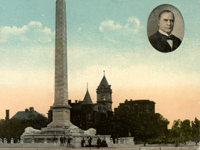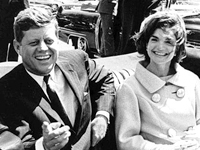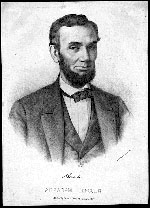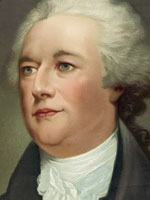Using Historical Footage (High School)
Why is the exchange between Welch and McCarthy historically significant?
Why is the exchange between Welch and McCarthy historically significant?
The granddaughter of Julius and Ethel Rosenberg discusses a documentary she has created for HBO that explores the question of whether they were really guilty.
Author Walter Isaacson discusses the life of Benjamin Franklin and his many contributions to the prosperity of colonial Philadelphia and his place in American history.
The feature may not appear on the first page.
The Meridian International Center promotes international communication and understanding via diplomacy and leadership exchanges.
The center offers more than 50 traveling trunks available to DC educators via their international resource library. These trunks contain items relevant to particular foreign countries.
New Harmony, IN, located on the banks of the Wabash River, preserves the history of a community that began almost 200 years ahead of its time, evolving from a spiritual sanctuary into a haven for international scientists, scholars, and educators who sought equality in communal living.
The site offers tours, exhibits, a short film, and educational and recreational programs.

On September 14, 1901, American anarchist Leon Czolgosz assassinated President William McKinley, propelling Theodore Roosevelt onto the U.S. political stage and, some historians would argue, making way for political modernization. Through hundreds of documents and images—including book chapters, newspaper articles and columns, sermons, poetry, and government documents—this website explores the McKinley assassination alongside U.S. politics and culture before and after.
Topics include turn-of-the-century journalism, race relations, anarchism, women's roles, the death penalty, international relations, and the Pan-American Exposition in Buffalo, NY, where McKinley was shot. A good place to begin is the "Quotes About" section, which provides short excerpts from a variety of sources that serve to familiarize users with conflicting views of McKinley, Czolgosz, Roosevelt, the assassination, Czolgosz's trial, and anarchism in the United States. All documents are keyword searchable and indexed by date, author, title, type, named persons, and source. An extensive bibliography provides suggestions for further reading.

This website is devoted to the life, work, and memory of John F. Kennedy, the 35th president of the U.S. Of primary interest to historians and teachers are the "Historical Resources and Education" and "Public Programs" sections of the website, which shed light on important events in early 1960s political history, including the Cuban missile crisis, the Vietnam War, the civil rights movement, the Peace Corps, the space program, and the 1963 Nuclear Test Ban Treaty. Users unfamiliar with the history of the Kennedy White House might begin with the "Timeline," which puts events important to the Kennedy administration in a larger political and cultural context, or "Biographies and Profiles," which presents a Kennedy family tree and profiles of early 1960s notables such as Fidel Castro, Robert McNamara, and Arthur M. Schlesinger, Jr. "White House Diary" further familiarizes users with Kennedy's day-to-day activities as President.
The website also includes hundreds of historical sources including speeches, photographs, telegrams, correspondence, eulogies for Bobby Kennedy, JFK, and Jacqueline Kennedy Onassis (all accessible through an Advanced Search feature), and transcripts of more than 170 oral interviews with notables such as John Kenneth Galbraith (Harvard University economic professor and Ambassador to India), Supreme Court Justice Felix Frankfurter, singer Harry Belafonte, and President Gerald Ford. In some cases, the original audio files of speeches are also included. Several lesson plans designed for elementary, middle, and high school students use materials from this archive to address topics such as Kennedy's inaugural address, the Cuban missile crisis, and the civil rights movement.

This website features approximately 20,000 documents relating to President Abraham Lincoln's life and career. All of the materials are available as page images and about half have been transcribed. Resources include correspondence, reports, pamphlets, and newspaper clippings. While the documents date from 1833 to 1897, most material was written between 1850 and 1865, including drafts of the Emancipation Proclamation and Lincoln's second inaugural address. A chronological index offers names of correspondents and document titles.
Special presentations on the Emancipation Proclamation and the Lincoln assassination provide introductions, timelines, and 24 images of related documents and engravings. Additional resources include 16 photographs of the Lincolns and key political and military figures of Lincoln's presidency. This is an excellent resource for researching Lincoln's presidency and American politics prior to and during the Civil War.

A while back, there was a Dirty Jobs episode all about safety. In the episode, Mike Rowe quoted a letter that Teddy Roosevelt wrote to his son. It included a section that said "there is nothing more dangerous than.... absolute safety" and there were three kinds of absolute safety in particular. Do you know where I can get a copy of this letter or what he said specifically?
I often watch Dirty Jobs. The episode on fishing for slime eels off the coast of Maine has to have been some of the most weirdly compelling television ever. Unfortunately, I did not see the episode about safety, "Safety Third," episode 05x18, which was first aired November 24, 2009.
Poking about the blogosphere for comments on that episode, I see that several people refer to the Roosevelt quote, and mention that it was from a letter that Roosevelt wrote to his son. The quote they refer to, however, is not from a letter to Roosevelt's son. It is part of a letter that Roosevelt wrote to Solomon Stanwood Menken, the head of the National Security League and the chairman of its Congress of Constructive Patriotism, on January 10, 1917. Roosevelt's younger sister, Mrs. Corinne Roosevelt Robinson, read the letter to a national meeting of the organization on January 26, 1917. The quote is in bold below, with more of the letter reproduced for context:
Americanism means many things. It means equality of rights and, therefore, equality of duty and of obligation. It means service to our common country. It means loyalty to one flag, to our flag, the flag of all of us. It means on the part of each of us respect for the rights of the rest of us. It means that all of us guarantee the rights of each of us. It means free education, genuinely representative government, freedom of speech and thought, equality before the law for all men, genuine political and religious freedom and the democratizing of industry so as to give at least a measurable equality of opportunity for all, and so as to place before us as our ideal in all industries where this ideal is possible of attainment, the system of cooperative ownership and management, in order that the tool users may, so far as possible, become the tool owners. Everything is un-American that tends either to government by a plutocracy or government by a mob. To divide along the lines of section or caste or creed is un-American. All privileges based on wealth, and all enmity to honest men merely because they are wealthy, are un-American—both of them equally so. Americanism means the virtues of courage, honor, justice, truth, sincerity, and hardihood—the virtues that made America.The things that will destroy America are prosperity-at-any-price, peace-at-any-price, safety-first instead of duty-first, the love of soft living and the get-rich-quick theory of life.
Preparedness must be of the soul no less than of the body. We must keep lofty ideals steadily before us, and must train ourselves in practical fashion so that we may realize these ideals. Throughout our whole land we must have fundamental common purposes, to be achieved through education, through intelligent organization and through the recognition of the great vital standards of life and living. We must make Americanism and Americanization mean the same thing to the native-born and to the foreign-born; to the man and to the woman; to the rich and to the poor; to the employer and to the wage-worker. If we believe in American standards, we shall insist that all privileges springing from them be extended to immigrants, and that they in return accept these standards with whole-hearted and entire loyalty. Either we must stand absolutely by our ideals and conceptions of duty, or else we are against them. There is no middle course, and if we attempt to find one, we insure for ourselves defeat and disaster.
The National Security League was founded by Menken and General Leonard Wood (the Army Chief of Staff) in December 1914. It emphasized the need for American "preparedness" in the face of challenges around the world. A swirl of various worries contributed to its rapid growth. Roosevelt echoed some of them here, including a conviction that American character had grown weak and soft, and so its ability to resist challenges had been dangerously reduced. Its young men had been "mollycoddled" by parents, especially mothers, who doted on them. The League's idea was to keep America at peace by keeping it strong. It formed the Military Training Camps Association of America, which operated summer camps for boys, the most successful one at Plattsburgh on Lake Champlain in upstate New York.
The League also heavily promoted (along with the American Legion and the American Red Cross) a 1915 movie, "The Battle Cry of Peace," starring Norma Talmadge in her first leading role, in which American pacifists, used as dupes by foreign agents, successfully lobby against defense spending. America is then invaded and New York and Washington are destroyed and enslaved. Admiral George Dewey and General Wood both played themselves in the film.
The challenges that the League had in mind were not only direct confrontations with foreign powers, which appeared to be looming in dark political clouds throughout Europe and Asia, but also more indirect confrontations within American society between democracy and its foes: an elite, moneyed oligarchy from the right, and a violent, fracturing anarchism from the left, both of which were popularly seen as being unnatural, foreign importations into America.
Among other efforts to promote American preparedness, the League proposed universal athletic and military training for young men, which would not only prepare them for possible battles, but also increase the general "vigor" of the population, and contribute to the assimilation of immigrants into the mainstream. Despite the League's early popularity across the spectrum of political allegiances, after a few years it lost most of its membership when it veered off into a form of xenophobic nativism that encouraged the formation of paramilitary units among youth.
Roosevelt, as is well known, was a firm believer in the virtues of physical exercise and adventures that tested and developed one's courage and inner resources. It is no surprise that he should criticize "safety-first instead of duty first." But he placed duty above physical prowess as well.
President Roosevelt wrote to his son Kermit, who was at Groton Academy, on October 4, 1903:
I am delighted to have you play football. I believe in rough, manly sports. But I do not believe in them if they degenerate into the sole end of any one's existence. I don't want you to sacrifice standing well in your studies to any over-athleticism; and I need not tell you that character counts for a great deal more than either intellect or body in winning success in life. Athletic proficiency is a mighty good servant, and like so many other good servants, a mighty bad master. Did you ever read Pliny's letter to Trajan, in which he speaks of its being advisable to keep the Greeks absorbed in athletics, because it distracted their minds from all serious pursuits, including soldiering, and prevented their ever being dangerous to the Romans? . . .. A man must develop his physical prowess up to a certain point; but after he has reached that point there are other things that count more.
On September 27, 1905, he wrote:
Have you started at your football? I think this is important, too, although of course it must be sacrificed to your studies if necessary. But it would be good for you to have the bodily development that comes from football, and it unquestionably has some effect in helping you with the other boys.
Roosevelt was very fond of football, of all organized team sports. But during 1905, his older son, Ted, played football on the freshman team at Harvard, and during the Harvard-Yale game, the young man appears to have had his nose broken deliberately by the Yale players, who laid him out on the field three times and kicked him in the face. It was all of a piece with an escalation of violence in college football that caused many schools to consider banning the sport. On October 9, 1905, the President wrote to Kermit:
To-day I see the football men of Harvard, Yale and Princeton, to try to get them to come to a gentleman's agreement not to have mucker play.
In fact, he invited two representatives from all three universities to the White House and voiced his concerns to them about the unsportsmanlike aura of unbridled violence that had come to be a feature of college football. Partly as a result of the publicity from this meeting, the college football association agreed the following year to a series of rule changes to the game that were meant to reduce pointless violence.
After Roosevelt left office and war broke out in Europe, he became heartsick at what he regarded as Woodrow Wilson's attempts to keep America out of the war despite German outrages on American lives and property. He attempted to raise a volunteer force to fight for the Allies and, defending the effort, Roosevelt wrote:
Let us pay with our bodies for our souls' desire. Let us, without one hour's unnecessary delay, put the American flag at the battle-front in this great war for Democracy and civilization, and for the reign of justice and fair-dealing among the nations of mankind.
He used his considerable influence to place his sons (with their eager permission) at the very front of the fighting when American forces were sent. He had already written the justification back in 1905, in an address he entitled "The Strenuous Life":
If we stand idly by, if we seek merely swollen, slothful ease and ignoble peace, if we shrink from the hard contests where men must win at the hazard of their lives and at the risk of all they hold dear, then the bolder and stronger peoples will pass us by, and will win for themselves the domination of the world.
Edmund Morris. Theodore Rex. New York: Random House, 2001.
Kathleen M. Dalton. Theodore Roosevelt: A Strenuous Life. New York: Alfred A. Knopf, 2002.
Sarah Lyons Watts. Rough Rider in the White House: Theodore Roosevelt and the Politics of Desire. Chicago: University of Chicago Press, 2003.
Proceedings of the Congress of Constructive Patriotism, held under the auspices of The National Security League, Washington, D.C., January 25-27, 1917. New York: National Security League, 1917, pp. 172-173.
Joan Paterson Kerr, ed. A Bully Father: Theodore Roosevelt's Letters to His Children. New York: Random House, 1995.
Theodore Roosevelt. "The Strenuous Life," pp. 1-21, and "The American Boy," pp. 155-164, in Theodore Roosevelt, The Strenuous Life: Essays and Addresses. New York: The Century Company, 1905.
Images:
Theodore Roosevelt in his library at Oyster Bay, New York, 1912, Prints and Photographs Division, Library of Congress.
Detail from Vitagraph Pictures' advertisement for "The Battle Cry of Peace," New York Times, September 12, 1915.

How did the debate between Jefferson and Hamilton shape the political system of the United States?
In George Washington’s Farewell Address (1796), the retiring president warned that the creation of political factions, “sharpened by the spirit of revenge,” would most certainly lead to “formal and permanent despotism.” Despite Washington’s cautionary words, two of his closest advisors, Thomas Jefferson and Alexander Hamilton, helped to form the factions that led to the dual party system under which the U.S. operates today. Other men, most notably James Madison and John Adams, also contributed to the formation of political parties, but Hamilton and Jefferson came to represent the divisions that shaped the early national political landscape.
Although both men had been active in the Revolutionary effort and in the founding of the United States, Jefferson and Hamilton did not work together until Washington appointed Jefferson the first secretary of State and Hamilton the first secretary of the Treasury. From the beginning, the two men harbored opposing visions of the nation’s path. Jefferson believed that America’s success lay in its agrarian tradition. Hamilton’s economic plan hinged on the promotion of manufactures and commerce. While Hamilton distrusted popular will and believed that the federal government should wield considerable power in order steer a successful course, Jefferson placed his trust in the people as governors. Perhaps because of their differences of opinion, Washington made these men his closest advisors.
Hamilton’s economic plan for the nation included establishing a national bank like that in England to maintain public credit; consolidating the states’ debts under the federal government; and enacting protective tariffs and government subsidies to encourage American manufactures. All of these measures strengthened the federal government’s power at the expense of the states. Jefferson and his political allies opposed these reforms. Francophile Jefferson feared that the Bank of the United States represented too much English influence, and he argued that the Constitution did not give Congress the power to establish a bank. He did not believe that promoting manufactures was as important as supporting the already-established agrarian base. Jefferson deemed “those who labour in the earth” the “chosen people of God . . . whose breasts he has made his peculiar deposit for substantial and genuine virtue.” He advised his countrymen to “let our work-shops remain in Europe.”
When George Washington’s administration began, the two camps that formed during the Constitutional ratification debates – those groups known as the Federalists and Anti-Federalists – had not yet solidified into parties. But, disagreements over the nation’s direction were already eroding any hope of political unity. In May of 1792, Jefferson expressed his fear to Washington about Hamilton’s policies, calling Hamilton’s allies in Congress a “corrupt squadron.” He expressed fear that Hamilton wished to move away from the Constitution’s republican structure, toward a monarchy modeled after the English constitution. That same month, Hamilton confided to a friend that “Mr. Madison cooperating with Mr. Jefferson is at the head of a faction decidedly hostile to me and my administration, and . . . dangerous to the union, peace and happiness of the Country.”
By the time Jefferson and John Adams vied for the presidency in 1796, political factions had formed under the labels “Republicans” and “Federalists.” In fact, by 1804 the advent of political parties necessitated a constitutional amendment that changed the electoral process to allow president/vice president tickets on the ballot. The Federalists dominated the national government through the end of the 18th century. Despite President Washington’s efforts at unity, political differences proved to be too deep to promote consensus. The Republican Party emerged as organized opposition to Federalist policies, and despite Jefferson’s assurances in his first inaugural address that Americans were “all republicans” and “all federalists,” faction had solidified into party.
George Washington, “Farewell Address,” Yale University, Avalon Project.
Thomas Jefferson, Notes on the State of Virginia, 1784, in David Waldstreicher, ed., Notes on the State of Virginia, and Related Documents. Boston: Bedford St. Martins Press, 2002. Can also be found online at the University of Virginia Library’s Electronic Text Center.
Thomas Jefferson to George Washington, May 23, 1792 and Alexander Hamilton to Edward Carrington, May 26, 1792 in Jefferson vs. Hamilton: Confrontations that Shaped a Nation, ed. by Noble E. Cunningham, Jr. Boston: Bedford St. Martins Press, 2000.
Thomas Jefferson, First Inaugural Address, 1801. Papers of Thomas Jefferson, ed. by Barbara Oberg. Princeton University Press, 2006. vol. 33: 148-152.
Cunningham, Noble E., Jr. ed. Jefferson vs. Hamilton: Confrontations That Shaped a Nation. Boston: Bedford St. Martin’s Press, 2000.
Read, James H. Power versus Liberty: Madison, Hamilton, Wilson, and Jefferson. Charlottesville: University of Virginia Press, 2000.
Staloff, Darren. Hamilton, Adams, Jefferson: The Politics of the Enlightenment and the American Founding. New York: Hill and Wang, 2005.